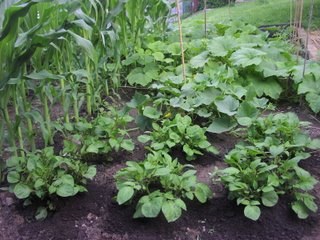Growing Potatoes

Solanum tuberosum
"O Creator! Thou who givest life to all things and hast made men that they may live, and multiply. Multiply also the fruits of the earth, the potatoes and other food that thou hast made, that men may not suffer from hunger and misery."
History
A high plateau in the Andean Mountains of South America is the most probable birthplace of the 'Irish' white potato that we eat today. The plateau, known today as the Titicaca Plateau, stretches across part of the countries of Peru and Bolivia. The Aymara Indians developed more than two hundred varieties of the potato at elevations greater than 10,000 feet. Potatoes formed the basis of the Aymara Indian and Incan diet.
Potatoes also were an important influence on Incan culture. Potato-shaped pottery complete with eyes is commonly found at excavated sites, sometimes having tiny heads growing out of the little eyes. Incan units of time correlated to the length of time it took for a potato to cook to various consistencies. Potatoes were even used to divine the truth and predict weather.
When the Spanish Conquistadors didn't find the gold and silver they were looking for in the late 1400s and early 1500s, they quickly cornered the local potato market. Potatoes were soon a standard supply item on their ships. The Spanish noticed that the sailors who ate papas (potatoes) did not suffer from scurvy. Scurvy is a disease associated with too little vitamin C in the diet. Potatoes have a lot of vitamin C, easily preventing scurvy.
Potatoes also were an important influence on Incan culture. Potato-shaped pottery complete with eyes is commonly found at excavated sites, sometimes having tiny heads growing out of the little eyes. Incan units of time correlated to the length of time it took for a potato to cook to various consistencies. Potatoes were even used to divine the truth and predict weather.
When the Spanish Conquistadors didn't find the gold and silver they were looking for in the late 1400s and early 1500s, they quickly cornered the local potato market. Potatoes were soon a standard supply item on their ships. The Spanish noticed that the sailors who ate papas (potatoes) did not suffer from scurvy. Scurvy is a disease associated with too little vitamin C in the diet. Potatoes have a lot of vitamin C, easily preventing scurvy.
An Irish legend says that ships of the Spanish Armada, wrecked off the Irish coast in 1588, were carrying potatoes and that some of them washed ashore.
The potato is a member of the nightshade family and its leaves are, indeed, poisonous. A potato left too long in the light will begin to turn green. The green skin contains a substance called solanine which can cause the potato to taste bitter and even cause illness in humans. Such drawbacks were understood in Europe, but the advantages, generally, were not.
Europe would wait until the 1780's before the potato gained prominence anywhere. About 1780 the people of Ireland adopted the rugged food crop. The primary reason for its acceptance in Ireland was its ability to produce abundant, nutritious food. Unlike any other major crop, potatoes contain most of the vitamins needed for sustenance. Perhaps more importantly, potatoes can provide this sustenance to nearly 10 people on an acre of land. This would be one of the prime factors causing a population explosion in the early 1800s. Of course, by the mid-1800's the Irish would become so dependent upon this crop that its failure would provoke a famine.
While in Ireland the potato gained acceptance from the bottom up, in France, the potato was imposed upon society by an intellectual.
Antoine Augustine Parmentier saw that the nutritional benefits of the crop combined with its productive capacity could be a boon to the French farmer. He was a pharmacist, chemist and employee of Louis XV. Parmentier discovered the benefits of the potato while held prisoner by the Prussians during the Seven Years War. He was so enamored by the potato that he determined that it should become a staple of the French diet. After failing by conventional means to convince Frenchmen of its advantages, he determined upon a surreptitious means of making his point.
Parmentier acquired a miserable and unproductive spot of ground on the outskirts of Paris. There, he planted 50 acres of potatoes. During the day, he set a guard over it. This drew considerable attention in the neighborhood. In the evening the guard was relaxed and the locals came to see what all the fuss was about. Believing this plant must be valuable, many peasants "acquired" some of the potatoes from the plot, and soon were growing the root in their own garden plots. Their resistance was overcome by their curiosity and desire to better their lot with the obviously valuable new produce – that and a bit of thievery!
History has more to tell on the subject, and I hope at the end of harvest season to post a few tried recipes that we have gathered this summer. Our small plot experiment consists of a bit of a patriotic theme, rather by chance than design, as we have red, white & blue potatoes planted and hope to continue with many seasons of saving & storing our ‘starter’ potatoes for future seasons.
Europe would wait until the 1780's before the potato gained prominence anywhere. About 1780 the people of Ireland adopted the rugged food crop. The primary reason for its acceptance in Ireland was its ability to produce abundant, nutritious food. Unlike any other major crop, potatoes contain most of the vitamins needed for sustenance. Perhaps more importantly, potatoes can provide this sustenance to nearly 10 people on an acre of land. This would be one of the prime factors causing a population explosion in the early 1800s. Of course, by the mid-1800's the Irish would become so dependent upon this crop that its failure would provoke a famine.
While in Ireland the potato gained acceptance from the bottom up, in France, the potato was imposed upon society by an intellectual.
Antoine Augustine Parmentier saw that the nutritional benefits of the crop combined with its productive capacity could be a boon to the French farmer. He was a pharmacist, chemist and employee of Louis XV. Parmentier discovered the benefits of the potato while held prisoner by the Prussians during the Seven Years War. He was so enamored by the potato that he determined that it should become a staple of the French diet. After failing by conventional means to convince Frenchmen of its advantages, he determined upon a surreptitious means of making his point.
Parmentier acquired a miserable and unproductive spot of ground on the outskirts of Paris. There, he planted 50 acres of potatoes. During the day, he set a guard over it. This drew considerable attention in the neighborhood. In the evening the guard was relaxed and the locals came to see what all the fuss was about. Believing this plant must be valuable, many peasants "acquired" some of the potatoes from the plot, and soon were growing the root in their own garden plots. Their resistance was overcome by their curiosity and desire to better their lot with the obviously valuable new produce – that and a bit of thievery!
History has more to tell on the subject, and I hope at the end of harvest season to post a few tried recipes that we have gathered this summer. Our small plot experiment consists of a bit of a patriotic theme, rather by chance than design, as we have red, white & blue potatoes planted and hope to continue with many seasons of saving & storing our ‘starter’ potatoes for future seasons.

The weather and rains have been good to us this summer and we are looking forward to a banner crop, in potatoes,
corn, pumpkins, tomatoes, cukes and now beets! (thanks again Herrick) We just transported and distributed several large bags of lettuce to our friends at church and family up north of us.
This season we grew Flame Lettuce, Green Slobolt and Red Leprechaun lettuce of which I had hoped to get a photo of but neglected to do so………..we hope to plant a second harvest this autumn so perhaps then. If I could recommend lettuce types I’d have to say these were a pleasing assortment for salads & sandwiches. Our seed stock for lettuce this year came from Seed Savers – high on our recommend list! I only wish in hindsight I let a few of the plants bolt to seed as to have my own plantings next go round, oh well.
Too bad I could not share some of this rain with Tom & John in Minnesota as I remember Tom’s saying last year “knee high by July and we currently are way past the waist and going to be saying “Head high this July!” As well we planted some cornfield pumpkins from Seed Savers and they are ‘running’ like tentacles of an octopus from 20000 Leagues Under the Sea .
The chickens are fairing well in their new home and enjoy their games of ‘tag’ and 'chase' when set free in the yard. We hope to be seeing some eggs soon as we received the baby chicks this February. The neighborhood cats have all stopped in at one point or time for a visit and to see the newest ‘attraction’. All is well here at the Holtzman Homestead.
To all who qualify in our readership – Happy Fathers Day!
Regards.
The chickens are fairing well in their new home and enjoy their games of ‘tag’ and 'chase' when set free in the yard. We hope to be seeing some eggs soon as we received the baby chicks this February. The neighborhood cats have all stopped in at one point or time for a visit and to see the newest ‘attraction’. All is well here at the Holtzman Homestead.
To all who qualify in our readership – Happy Fathers Day!
Regards.


3 Comments:
Great post Scott!
We're a bit behind you on growth with the plants, but that's normal I'd figre. Glad to hear things are doing that good in your neck of the woods!
Tom
Hi Scott!
That was an interesting bit of history on the potato.
I'm glad to hear that all is well and that your gardens and chickens are doing well also.
Our gardens are doing incredible considering we have had so little rain this spring. But we irrigate and the early spring, warm weather and lots of sunshine has worked its miracles.
Best wishes and may God bless!
Hi there
Im looking for blogs about potato growing. We are growing some ourself but there is a problem with them. Any chance a budding potato grower could nip to my blog and look at the photo - see if they can tell me whats up? I'd greatly appreciate it.
Hazel (Ireland)
http://hazel-athome.blogspot.com/2006/07/help-bad-potatoes.html
Post a Comment
<< Home